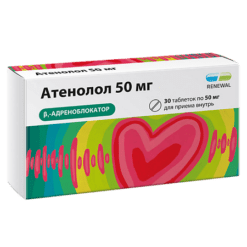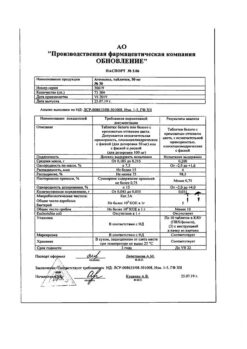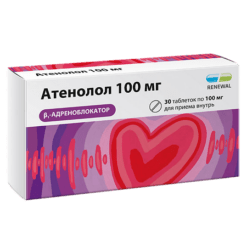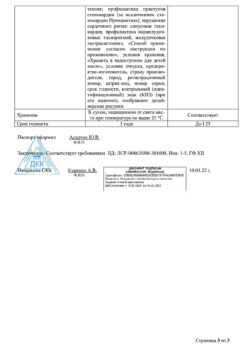No products in the cart.
Atenolol, 25 mg 30 pcs
€0.76 €0.69
Description
It has antianginal, antihypertensive and antiarrhythmic effects. It does not have membrane stabilizing and intrinsic sympathomimetic activity. Reduces catecholamine-stimulated formation of cyclic adenosine monophosphate (cAMP) from adenosine triphosphate (ATP), reduces intracellular calcium ion current. During the first 24 h after oral administration against the background of decreased cardiac output, there is a reactive increase in total peripheral vascular resistance, which during 1-3 days gradually returns to the baseline, and then gradually decreases. Antihypertensive effect is associated with reduction of the blood minute volume, decrease of renin-angiotensin-aldosterone system activity, baroreceptor sensitivity and influence on the central nervous system. Antihypertensive effect is manifested by both reduction of systolic and diastolic blood pressure (BP), reduction of stroke and minute blood volume. In medium therapeutic doses, it has no effect on peripheral arterial tone. The antihypertensive effect lasts for 24 hours and with regular use is stabilized by the end of the second week of treatment. The antianginal effect is determined by a decrease in myocardial oxygen demand due to a decrease in heart rate (prolongation of diastole and improvement of myocardial perfusion) and contractility, as well as by a decrease in myocardial sensitivity to sympathetic stimulation. It reduces heart rate (HR) at rest and during exercise. By increasing left ventricular end-diastolic pressure and increasing ventricular muscle fiber stretch may increase oxygen demand, especially in patients with chronic heart failure. Antiarrhythmic action is manifested by suppression of sinus tachycardia and is associated with the elimination of arrhythmogenic sympathetic effects on the cardiac conduction system, reducing the rate of spread of excitation through the sinoatrial node and lengthening the refractory period. It suppresses conduction of impulses in antegrade and, to a lesser extent, in retrograde direction through AV (atrioventricular) node and along additional conduction pathways. The negative chronotropic effect appears 1 hour after intake, reaches its maximum after 2-4 hours and lasts up to 24 hours. It reduces the automatism of the sinus node, slows heart rate, slows AV conduction, reduces myocardial contractility, reduces myocardial oxygen demand. It reduces myocardial excitability. When used in medium therapeutic doses, it has less pronounced effect on bronchial smooth muscle and peripheral arteries than non-selective beta-adrenoblockers. It increases survival of patients who have had myocardial infarction (reduces the incidence of ventricular arrhythmias and angina attacks). Practically does not weaken the bronchodilator effect of isoprenaline. Unlike non-selective beta-adrenoblockers, when administered in medium therapeutic doses, it has less pronounced effect on the organs containing beta2-adrenoreceptors (pancreas, skeletal muscles, smooth muscle of peripheral arteries, bronchi and uterus) and on carbohydrate metabolism. To a lesser extent, it has negative butmo-, chrono-, ino- and dromotropic effects. When used in high doses (more than 100 mg/day) has a blocking effect on both beta-adrenoreceptor subtypes.
Indications
Indications
Arterial hypertension; prevention of angina attacks (with the exception of Prinzmetal angina); heart rhythm disturbances: sinus tachycardia, prevention of supraventricular tachyarrhythmia, ventricular extrasystole.
Pharmacological effect
Pharmacological effect
It has antianginal, antihypertensive and antiarrhythmic effects. It does not have membrane stabilizing or internal sympathomimetic activity. Reduces the formation of cyclic adenosine monophosphate (cAMP) stimulated by catecholamines from adenosine triphosphate (ATP), reduces the intracellular current of calcium ions. In the first 24 hours after oral administration, against the background of a decrease in cardiac output, a reactive increase in total peripheral vascular resistance is observed, which gradually returns to the original value within 1-3 days, and then gradually decreases. The antihypertensive effect is associated with a decrease in minute blood volume, a decrease in the activity of the renin-angiotensin-aldosterone system, baroreceptor sensitivity and an effect on the central nervous system. The antihypertensive effect is manifested by both a decrease in systolic and diastolic blood pressure (BP), a decrease in stroke and minute blood volume. In average therapeutic doses it has no effect on the tone of peripheral arteries. The antihypertensive effect lasts 24 hours, and with regular use it stabilizes by the end of the second week of treatment. The antianginal effect is determined by a decrease in myocardial oxygen demand as a result of a decrease in heart rate (prolongation of diastole and improvement of myocardial perfusion) and contractility, as well as a decrease in the sensitivity of the myocardium to the effects of sympathetic stimulation. Reduces heart rate (HR) at rest and during physical activity. By increasing end-diastolic pressure in the left ventricle and increasing the stretch of ventricular muscle fibers, it may increase oxygen demand, especially in patients with chronic heart failure. The antiarrhythmic effect is manifested by suppression of sinus tachycardia and is associated with the elimination of arrhythmogenic sympathetic influences on the conduction system of the heart, a decrease in the rate of propagation of excitation through the sinoatrial node and an extension of the refractory period. It inhibits the conduction of impulses in the antegrade and, to a lesser extent, in the retrograde directions through the AV (atrioventricular) node and along additional conduction pathways. The negative chronotropic effect appears 1 hour after administration, reaches a maximum 2-4 hours later, and lasts up to 24 hours. Reduces the automaticity of the sinus node, reduces heart rate, slows AV conduction, reduces myocardial contractility, and reduces myocardial oxygen demand. Reduces myocardial excitability. When used in average therapeutic doses, it has a less pronounced effect on the smooth muscles of the bronchi and peripheral arteries than non-selective beta-blockers. Increases the survival rate of patients who have had myocardial infarction (reduces the incidence of ventricular arrhythmias and angina attacks). Practically does not weaken the bronchodilating effect of isoprenaline. In contrast to non-selective beta-blockers, when prescribed in average therapeutic doses, it has a less pronounced effect on organs containing beta2-adrenergic receptors (pancreas, skeletal muscles, smooth muscles of peripheral arteries, bronchi and uterus), and on carbohydrate metabolism. To a lesser extent it has a negative bathmo-, chrono-, ino- and dromotropic effect. When used in large doses (more than 100 mg/day), it has a blocking effect on both subtypes of beta-adrenergic receptors.
Special instructions
Special instructions
Use with caution in diabetes mellitus, COPD (including bronchial asthma, emphysema), metabolic acidosis, hypoglycemia; history of allergic reactions, chronic heart failure (compensated), obliterating diseases of peripheral arteries (intermittent claudication, Raynaud’s syndrome), pheochromocytoma, liver failure, chronic renal failure, myasthenia gravis, thyrotoxicosis, depression (including a history), psoriasis, during pregnancy, in elderly patients, in pediatrics (efficacy and safety have not been determined).
When using atenolol, it is possible to reduce the production of tear fluid, which is important for patients who use contact lenses.
Atenolol should be withdrawn gradually after a long course of treatment under medical supervision.
When stopping the combined use of atenolol and clonidine, treatment with clonidine is continued for several more days after atenolol is discontinued, otherwise severe arterial hypertension may occur.
If inhalation anesthesia is necessary in patients receiving atenolol, a few days before anesthesia, it is necessary to stop taking atenolol or select an anesthetic agent with minimal negative inotropic effect.
Impact on the ability to drive vehicles and operate machinery
In patients whose activities require increased concentration, the issue of outpatient use of atenolol should be decided only after assessing the individual response.
Active ingredient
Active ingredient
Atenolol
Composition
Composition
Active substance: atenolol – 25.0 mg
Contraindications
Contraindications
AV blockade II and III degrees, sinoatrial blockade, SSSU, bradycardia (heart rate less than 40 beats/min), arterial hypotension (if used for myocardial infarction, systolic blood pressure less than 100 mm Hg), cardiogenic shock, chronic heart failure stage IIB-III, acute heart failure, Prinzmetal angina, period lactation, simultaneous use of MAO inhibitors, hypersensitivity to atenolol.
Side Effects
Side Effects
From the cardiovascular system: in some cases – bradycardia, arterial hypotension, AV conduction disturbances, the appearance of symptoms of heart failure.
From the digestive system: at the beginning of therapy, nausea, constipation, diarrhea, and dry mouth are possible.
From the nervous system: at the beginning of therapy, fatigue, dizziness, depression, mild headache, sleep disturbances, a feeling of cold and paresthesia in the extremities, a decrease in the patient’s reactivity, a decrease in the secretion of tear fluid, and conjunctivitis are possible.
From the endocrine system: decreased potency, hypoglycemic conditions in patients with diabetes mellitus.
From the respiratory system: in predisposed patients – the appearance of symptoms of bronchial obstruction.
Allergic reactions: skin itching.
Other: increased sweating, redness of the skin.
Interaction
Interaction
With simultaneous use of diuretics, the antihypertensive effect is enhanced.
With the simultaneous use of inhalation anesthesia, the risk of increased cardiodepressive effects and the development of arterial hypotension increases.
There are reports of the development of bradycardia and arterial hypotension with simultaneous use of alcuronium chloride.
With simultaneous use of verapamil, the negative inotropic effect increases, bradycardia, bradyarrhythmia, and severe conduction disturbances develop; Cases of postural hypotension, dizziness, left ventricular failure, and lethargy have been described. Under the influence of verapamil, the pharmacokinetic parameters of atenolol do not change significantly, although a case of an increase in the AUC of atenolol has been described.
With simultaneous use of disopyramide, Css increases, disopyramide clearance decreases, and conduction disturbances are possible.
With the simultaneous use of dipyridamole, a case of the development of bradycardia and then asystole has been described (during an ECG test with dipyridamole in a patient receiving atenolol).
With the simultaneous use of indomethacin, naproxen and other NSAIDs, it is possible to reduce the antihypertensive effect of atenolol, which is to a certain extent due to the disruption (under the influence of NSAIDs) of the synthesis in the kidneys and the release into the bloodstream of prostaglandins PGA and PGE, which have a strong vasodilating effect on peripheral arterioles.
With the simultaneous use of insulin, an increase in blood pressure is possible.
With simultaneous use of clonidine, additive hypotensive effects, sedation, and dry mouth are possible.
With simultaneous use of caffeine, the effectiveness of atenolol may be reduced.
With simultaneous use of nizatidine, a case of increased cardiodepressive effect has been described.
With simultaneous use of nifedipine, cases of severe arterial hypotension and heart failure have been described, which may be due to an increased inhibitory effect of nifedipine on the myocardium.
With simultaneous use of orlistat, the antihypertensive effect of atenolol is reduced, which can lead to a significant increase in blood pressure and the development of a hypertensive crisis.
With simultaneous use of prenylamine, an increase in the QT interval is possible.
With simultaneous use of chlorthalidone, the antihypertensive effect is enhanced.
Overdose
Overdose
Symptoms: severe bradycardia, AV block II-III degree, increasing symptoms of heart failure, excessive decrease in blood pressure, difficulty breathing, bronchospasm, dizziness, fainting, arrhythmia, ventricular extrasystole, cyanosis of fingernails or palms, convulsions.
Treatment: gastric lavage and administration of adsorbent drugs; if bronchospasm occurs, inhalation or intravenous administration of the beta2-adrenergic agonist salbutamol is indicated. In case of impaired AV conduction, bradycardia – intravenous administration of 1-2 mg of atropine, epinephrine or installation of a temporary pacemaker; for ventricular extrasystole – lidocaine (class 1A drugs are not used); when blood pressure decreases, the patient should be in the Trendelenburg position. If there are no signs of pulmonary edema – intravenous plasma replacement solutions, if ineffective – administration of epinephrine, dopamine, dobutamine; for chronic heart failure – cardiac glycosides, diuretics, glucagon; for convulsions – intravenous diazepam. Dialysis is possible.
Manufacturer
Manufacturer
Ozon, Russia
Additional information
| Manufacturer | Ozon, Russia |
|---|---|
| Medication form | pills |
| Brand | Ozon |
Other forms…
Related products
Buy Atenolol, 25 mg 30 pcs with delivery to USA, UK, Europe and over 120 other countries.



















